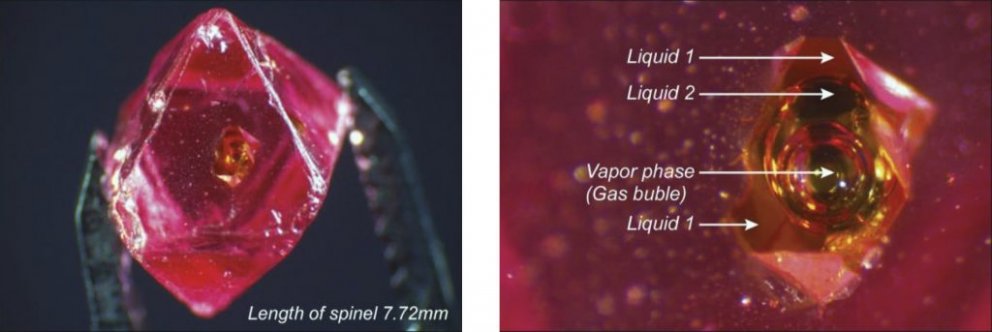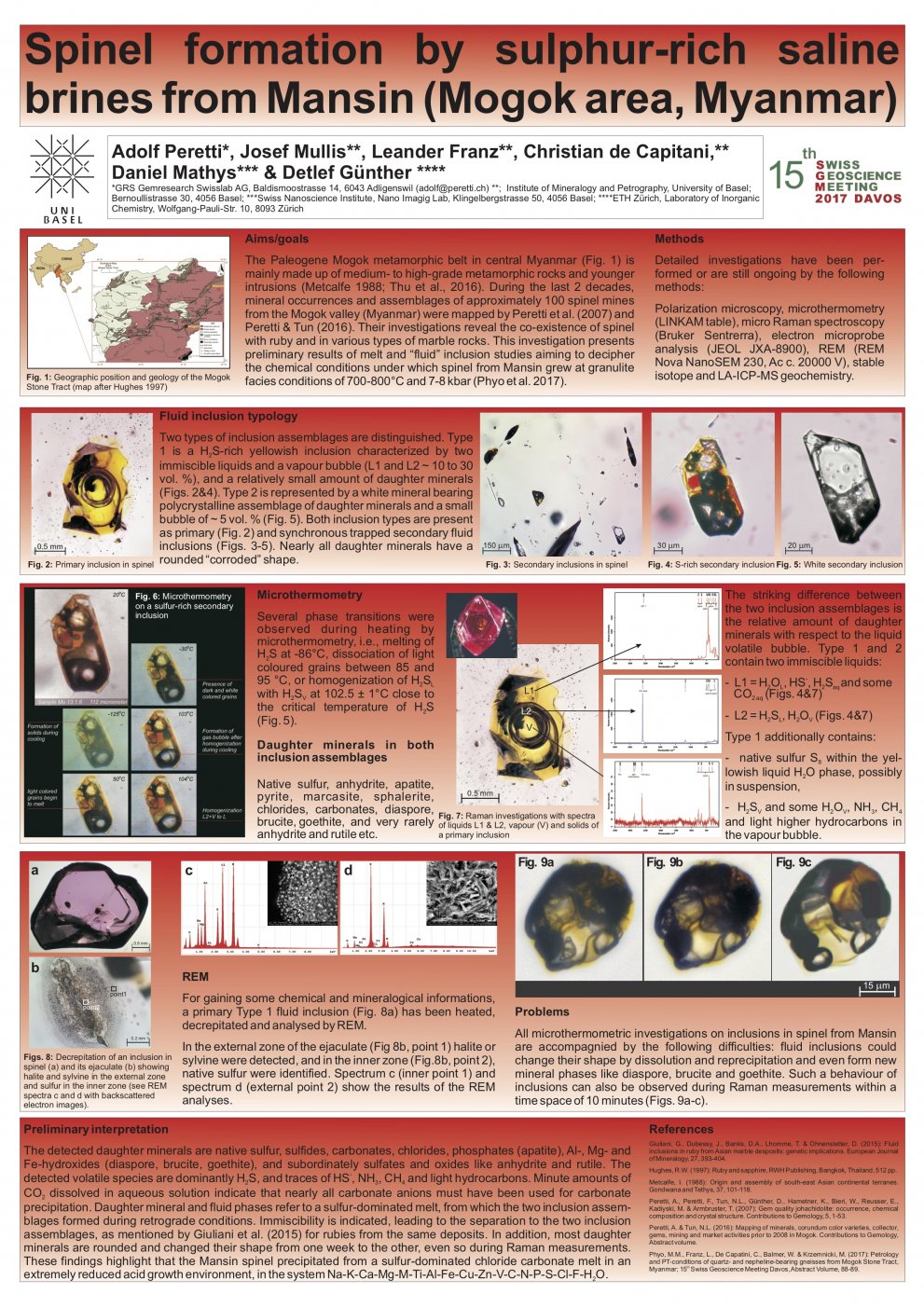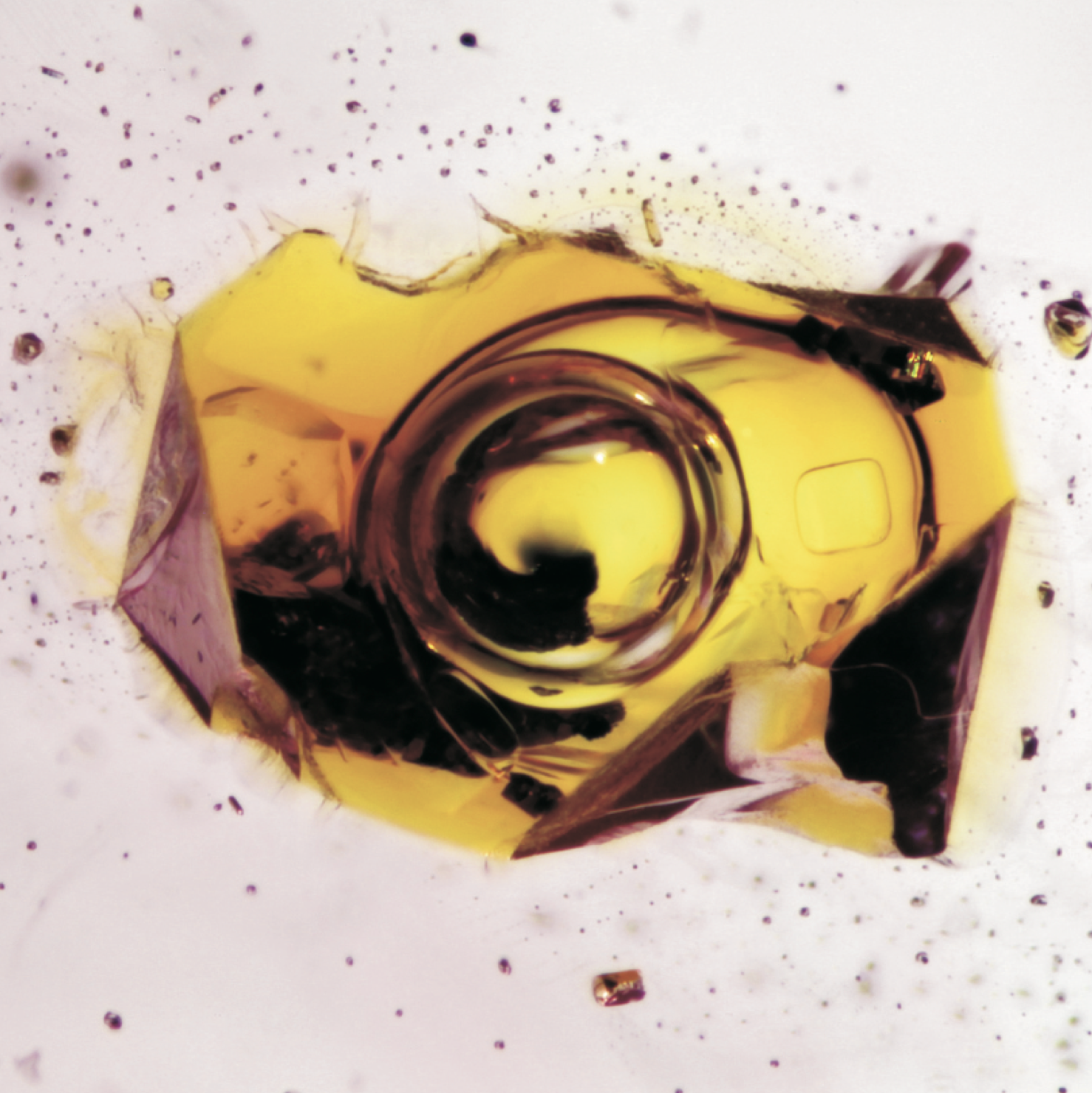Spinel formation by sulphur-rich saline brines from Mansin (Mogok area, Myanmar)
During the last 2 decades, one of the authors has mapped the mineral occurrences in the Mogok valley and registered the mineral assemblages of approximately 100 spinel mines in a profile of 30 km length (first part published in Peretti et al., 2007 and Peretti & Tun 2016).
Abstract from 15th Swiss Geoscience Meeting 2017 (Davos, Switzerland)
- GRS Gemresearch Swisslab AG, Baumschulweg 13, CH-6045 Meggen (adolf@peretti.ch)
- Institute of Mineralogy and Petrography, University of Basel, Bernoullistrasse 32, CH- 4056 Basel
- ETH Zürich, Laboratory of Inorganic Chemistry, Wolfgang-Pauli-Str. 10, CH-8093 Zürich
The map of the mineral occurrences shows the co-existence of spinel with ruby and sapphire in various types of marble rocks. Different colour varieties of spinel were found including fancy spinel, vivid red spinel and vibrant pinkish-red spinel. The variable colours of spinel may be due to the influence of trace elements from different types of metasedimentary or intrusive rocks in the environment of the marbles and changes in fluid compositions and formation conditions.
Detailed investigations with different methods (microthermometry, Raman spectroscopy, stable isotope and LA-ICP-MS geochemistry) are ongoing on spinel of one of the commercially most important mine, the Mansin mine. Its rock suite was investigated and sampled by detailed field work. The Mansin spinels formed in an impure layered dolomitic marble with layers of olivine, sulfides and spinel. There are indications for the influx of fluids that created halos in the marble forming Fe-rich dolomite.
To characterize the growth conditions of the Mansin spinels, fluid and solid inclusions were investigated in detail. At least two types of fluid inclusion assemblages are distinguished. Based on the actual knowledge, they were more or less simultaneously trapped as immiscible fluids (Giuliani et al. 2015) in the system Na? – K? – Ca – Mg – Al – Fe – Zn – SO4 – Cl – H2S – H2O, with traces of some volatiles. These fluid inclusions may contain accidentally trapped minerals like phlogopite, calcite and retrograde precipitated daughter mineral phases, i.e. native sulphur, different salts, diaspore, brucite, calcite, goethite, pyrite, marcasite, sphalerite, fluorapatite, etc. One fluid inclusion assemblage is characterized by an H2S bubble of 10 to 35 vol.% and a series of daughter minerals. In contrast, the H2S bubble of the second fluid inclusion assemblage is markedly smaller (3-5 vol.%), but nearly totally filled with daughter minerals. A striking feature of the first inclusion assemblage is the presence of two immiscible yellowish liquid phases (L1 and L2 at room temperature) and a vapour bubble (Fig. 1). The homogenization temperature of the L1 with the vapour phase lies at 101 ± 2 °C, close to the critical temperature of H2S, which has been verified by Raman spectroscopy. An additional striking feature is the presence of large rounded, Raman inactive solids which are interpreted as salts.
Based on these preliminary results we conclude that the formation of spinel from Mansin was triggered by a very sulphur-rich, highly saline brine.


References
Giuliani, G., Dubessy, J., Banks, D.A., Lhomme, T. & Ohnenstetter, D. 2015: Fluid inclusions in ruby from Asian marble desposits: genetic implications. European Journal of Mineralogy, 27, 393-404.
Peretti, A., Peretti, F., Tun, N.L., Günther, D., Hametner, K., Bieri, W., Reusser, E., Kadiyski, M. & Armbruster, T. 2007: Gem quality johachidolite: occurrence, chemical composition and crystal structure. Contributions to Gemology, 5, 1-53.
Peretti, A. & Tun, N.L. 2016: Mapping of minerals, corundum color varieties, collector, gems, mining and market activities prior to 2008 in Mogok. Contributions to Gemology, Abstract volume.
Links
https://script.nanoscience.unibas.ch/nanoimaging/files/Mullis-Poster.pdf
© 2023, GRS GemResearch Swisslab AG

